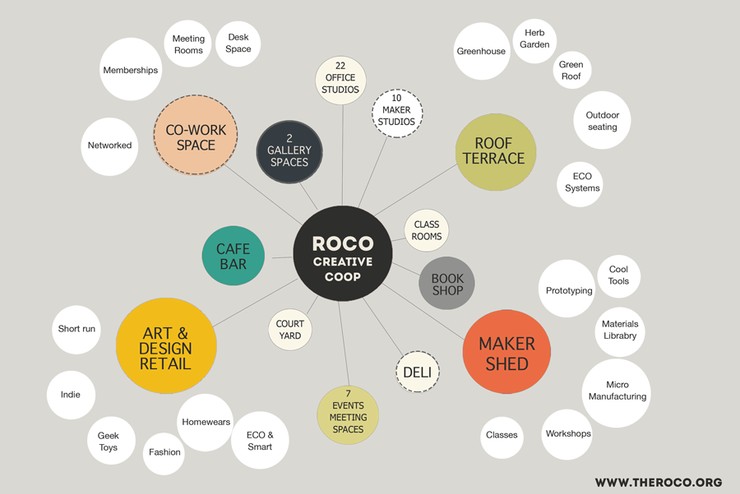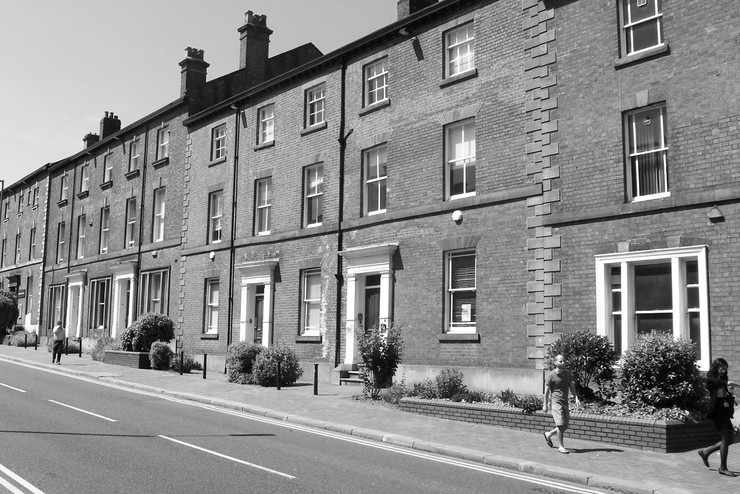
© Roco
You are opening in November so first off; apologies for bugging you at what must be a hectic time. What is still left to fall into place?
Well you catch us eight weeks away from opening so in a practical sense most of it! We will be making the extension watertight this week, installing the windows and doors and the green roof system on our cafe bar terrace.
More broadly speaking, we are almost three years into the project. Three years from raising the initial £10,000 loan we needed to develop the model to where we are now: recruiting the core management team and beginning installing equipment in our maker space.
So, to answer the question, we are somewhere near the end of a very long and intricate chain of dominos really, and I’m making sure all the pieces keep moving!
The map of Roco’s spaces and contents is sprawling, ambitious and genuinely exciting. Who was part of the team who came up with the vision and put it in motion?
Both Chris Hill and I (co-founder) wanted to focus on what we could add to the existing business support or business incubation model. The idea of clustering or providing space for like-minded businesses to work in has been around for many years, from the industrial scale innovation parks supporting engineering and manufacturing, to the more recent iteration of the lean business accelerator, which is often seen in the tech world. From my perspective, there is something about those types of spaces that feels both physically and ideologically quite disconnected from the communities they exist in.
I think there's a difference with the creative industries. Creative and culturally focused people, the designers, artists and makers, are in many ways interconnected with the community in which they operate. We exist within the broader 'culture' and enjoy catching a film or a gig, buying art for our walls and a decorative piece for the sideboard and in turn contributing to the general output and milieu of our city.

© Roco
Andrea's Roco mind map.
In realising this, it was fundamental that Roco connect with our broader culture by bringing everyone together under one roof, the public mingling with businesses, inspiring shared ideas and making spaces. So we designed the building layout around a variety of open and private spaces; co-working, deli, retail, maker-spaces, bookshop, studios, courtyards all circling back to the place where all good ideas go to meet – the cafe bar.
I trained as a designer and I’m also dyslexic, so to me there was only really one way to rationalise the solution to the problem of how we support and inspire creativity and culture in Sheffield. By refining and redefining a 30 page business plan into a one page illustration I could see how Roco's interconnected parts would work and build the framework to hang our ideas off.
What kind of services do you hope the Roco will be able to provide its tenants?
In a very broad sense we do three things for our tenants: we provide a home to set up and run a business, we provide them with tools to make and manufacture their wares - whether that be physical objects or creative ideas - and we provide a route to market through our retail spaces and our gallery and project spaces.
In addition to this, we will be providing inspiration and brain food in the form of workshops, events, and exhibitions hosted in our gallery, through our humanities focused bookshop and, of course, opportunities though our business development programme.

© Roco
Could you tell us a little about the beautiful building that will house the Roco?
Roco is based across seven Grade II listed Georgian terrace houses in the heart of the city, built between 1820 and 1840. They each have their own individual character along with the quirks of being built nearly 200 years ago. We have worked with Nick Brown Architects to try and reimagine the buildings, focusing on preserving the original features while joining together and expanding the spaces to make them useful once again in a modern context.
What have been the major challenges in setting up a cooperatively owned venture? Have you had any help?
It’s probably useful to define what our particular co-op model is. In simple terms we are a group of people that have invested time, money and skills to establish a not-for-profit co-op that is owned by its members. We offer share investors a one vote membership which brings the community directly into the process of running and building the organisation.
Setting up the co-op was actually fairly straightforward, after jumping through a few legal hoops. The biggest challenge by far to getting the project off the ground was raising the £1.2m capital needed from outside investors which took over two years.
We can sell shares in our co-op to our members (at present, nearly 50), as a not-for-profit we don't pay dividends but we do pay 5% interest much like a decent ISA.

© Roco
In total, our members have invested almost £100,000. From architects to silversmiths, our members have provided nearly 10% of the total cost of the project. It was through this very real, socially-focused action that our larger investors saw that we are developing a project with and for the support of Sheffield's creative community and so eventually took the leap to finance the build.
But the next step is the really exciting bit. It's an opportunity to pool the myriad talents and resources of our community and use their skills and imagination to design products and services that provide a positive social impact.
Sheffield has a really vibrant spirit of creativity and social awareness, we are looking to galvanize some of the excitement and interest around social and environmental innovation to think about the positive interventions, products and services we could make that will ultimately do society and our community some good.

© Roco
How does the Roco fit into the cultural landscape of Sheffield? Which spaces and organisations do you see as helping foster the arts in the city?
Sheffield has a number of different types of creative, cultural and socially engaged organisations across the city. For example we have vibrant artist studio scene with S1 Artspace, Yorkshire Artspace and Bloc all being well established successful projects. We have The Workstation and Electric Works leading the charge on high-tech and digital and we have projects like Re-New Sheffield, CADS and Union Street Co-working who are doing great things for grassroots arts and social enterprise projects.
What we hope to do is add something unique to the landscape. Even though we have over 2200 creative businesses within the city, and some 20,000 people employed in the sector, Sheffield as a whole has been slow to champion its creative and cultural sector in the same way as other cities like Manchester or Newcastle. We see our role as building a platform from which to shout about the amazing talent this city has hiding in its foothills, a place where we can all come together to make, to work, and to play.
Andrea Burns is a creative entrepreneur, owner of Huella and co-founder of the Roco.